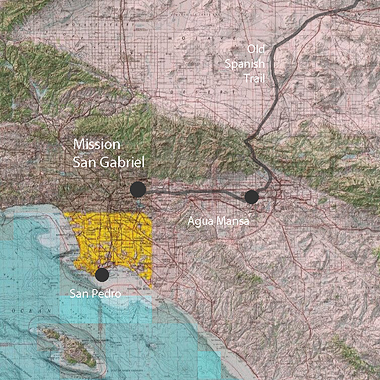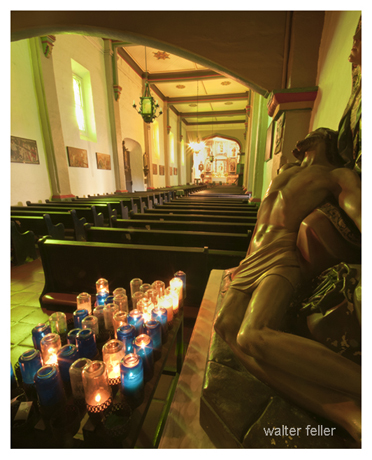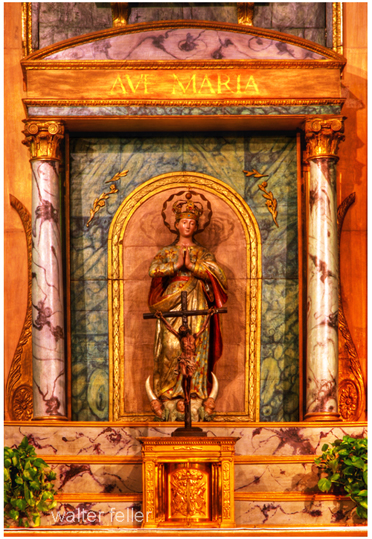Mission San Gabriel
After the peaceful 15 days rest, Smith secured guides and crossed the Mojave Desert via the Mojave River Trail, essentially following Garces' route. Smith named the river "in constant," because he kept disappearing in the sand. When the transcontinental trappers arrived in San Gabriel in November 27, 1826, they took the Mexican authorities by surprise the trappers were looked upon with suspicion and their two Indian guides were locked up the second day and remain so for at least three days, after which neither Smith nor Rogers mentioned them either they were runaways or the Mexican authorities intended to keep the Mohave Indians at a distance. In contrast, the priests in San Gabriel, especially Father José Bernardo Sanchez, treated the trappers with utmost cordiality. The hospital welcome by the San Gabriel missionaries was repeatedly praised by Harrison G Rogers, Smith's clerk and second-in-command. Rogers and Smith were constantly affected at the missionaries table. Rogers was in script used to the priest over a glass of "good old whiskey and found them to be very friendly gentleman…" As days progressed, wine, "sigar's," gin, varieties of bread and cheese is supplemented the main meals. On November 29, 1826, for example, Rogers wrote: "We was sent for about sunrise to drink a cup of tea, and eat some bread and cheese." They were treated like "bretheren," he continued, even though the trappers were in rags and they could not speak the Spanish language. At 11 o'clock they had gin and water, bread and cheese, and then dinner.There's Southern California's stay of two months was filled with interest. After Smith and Rogers and several days writing letters and making maps of their Overland track, Smith was called to San Diego, where he spent almost 6 weeks trying to explain his presence in the country to Gov. José Maria Encheandia. In fact, he had to send back to San Gabriel for eight beaver pelts, for the Mexican scarcely knew about beavers. With the aid of some American ship captains, Smith received permission to leave California the way he entered, but could not secure permission to trap his way to Oregon. Rogers, in the meantime, kept the rest of the men busy at San Gabriel. They made themselves clothing, worked in the blacksmith shop, made a bear trap at the Padres request, and even made a trap to catch some Indians who came to the orchard to steal "orranges" [sic]. Some men cut wood for the soap factory. Arthur Black and John Gaidar work for them missions for three days and received a horse apiece. Rogers had saddles and packs made for the journey out of California. The newly-obtained horses had to be taken care of, and in some cases even had to be broken.
Their winter's day was interrupted by much enjoyment and a few moments of disgust. Rogers recorded in his diary many pleasant hours. He reported that he went hunting with the commander of saying Gabriel's troops. With the priest he played cards, even on Sundays, and discuss the merits of Calvinism and Catholicism. They attended weddings and holiday festivities. Also on Sundays, the men were treated with extra rations of wine after the church services. The trappers seem to be amused at the little group of Indian musicians used for the Sunday services, but balked at the complete subjugation of Indians who were whipped by the soldiers for sundry reasons, Inc. including drunkenness and gambling. Once after the Sunday meet was issued to the Indians, a priest of oranges to the young squash and watch some squabble over them.
On Monday, January 8, 1827, Rogers related that he had attended a great fandango or dance the night before, and revealed is discussed with the unchaste women who think "it an honnour [sic] to ask a white man to sleep with that." He was propositioned by one who came to his room, but he said she was so forward he was ashamed to "teach her." The other trappers were probably less inhibited.
The priests were quite tolerant of the Americans conduct, even when some trappers partook of too much liquid hospitality. Once, James Reed had to be flogged by Smith for impertinence. But generally this day was a pleasant one for the Americans. In fact, when they were leaving, Daniel Ferguson decided he liked his life so well that he hid out and deserted.
Smith finally returned from San Diego, securing from mission to depart on the route by which he had arrived. The trappers went to the Indian "farm" (settlement) at San Bernardino. Smith had permission from the governor to obtain supplies and in order form from "old father Sanchez" for the majordomo at San Bernardino to give all the supplies needed. Here Smith received, evidently free, clothing and such food as milk, corn, these, parched meal, wheat flour. They exchange six old horses for wild mares which had to be broken. These brought their total to 68 animals.
From here, according to Smith's letter to Clark, they
-
" . . . went eastward of the Spanish settlement on the route I had come in. I then scared my course northwest keeping from 150 miles to 200 miles from the seacoast."
Smith wasted no time in making preparations for relieving his men in California. You acquired the necessary supply symbol by July 13, 1827 had 18 men, either to risk their futures for the fortunes in California. "I of course expected to find beaver," wrote Smith to Gen. William Clark, "which with us hunters is a primary object, but I was also led on by love of novelty common to all…" Smith started towards the Mojave Trail, but another trapping expedition changed what would seem like a smooth, peaceful reentry of the route he had already forged.
< Previous - Next >
Independence
Barring Interferences & Calamities
Successful Trading
Mission San Gabriel
This Illustrious Group
The Chastised Mohave
Another Band of Hunters
Deception
Movements through the Mojave
Finding a New Route
The Race for Profits

Location of the San Gabriel Mission

Inside the original chapel

Alter at the church